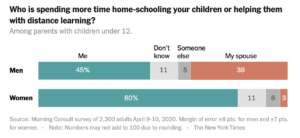In June 2021, Emtrain presented a webinar titled Get Ready to Welcome Women Back to Work. The webinar addressed some of the disproportionate effects that COVID-19 had on working women, particularly working mothers, and aimed to provide employers with tools to build equitable infrastructure and inclusive recruitment practices. We are living in a candidate’s job market at the moment. With a high volume of very qualified candidates looking for jobs, employers need to position their workplace culture as one that prioritizes the employee experience, and accommodates the needs of working parents.
Some statistics
Throughout the COVID-19 pandemic, there was overwhelming data showing that the financial and social fallout is disproportionately affecting working mothers. A McKinsey study found that upwards of 2.2 million women are considering leaving the workforce. Working mothers are 1.5 times more likely than working fathers to spend an additional 4 hours on housework and childcare. The US Bureau of Labor Statistics reported that of the 1.1 million people who left work in September of 2020, 80% of those people were women.

Additionally, the New York Times reported that the division of labor at home varies dramatically between women and men. Nearly half of men say that they do most of the childcare work when it comes to distance learning, while 3% of women say the same thing about their husbands. This speaks eons to some of the challenges working women face when working from home, and the sympathy towards them.
With schools reopening and workplaces restaffing, many of these individuals who have left the office will be back in the job market. The most qualified, most desired applicants are going to have a lot of bargaining power. In the past year, we’ve learned that people want to work for companies that value diversity, equity, and inclusion. With this in mind, how can companies position themselves as an employer that values these things, and what systems and processes can they put in place to follow up on those values?
What is inclusive infrastructure?
Emtrain’s workplace culture platform uncovered that only 52% of individuals feel their organization has a genuine commitment to inclusion. This information does not bode well for employers trying to step up their inclusion practices. Employee perception is everything. Additionally, only 50% of employees believe their company is unhealthy as it relates to diversity and inclusion. Clearly, there’s still work to do. Employers need to go beyond making statements, donating to charitable organizations, and social media posts. It’s all about building inclusive infrastructure. Inclusive infrastructure are workplace policies and procedures that accommodate different employees needs, abilities, availability, or any other special circumstance.
There are several workplace policies that an employer can put into place to accommodate working mothers. Flex hours is a great start. Allow employees to take the necessary time to be with their families, by encouraging them to set their own hours. Normalize parents blocking time off their calendars for school drop-off and pick-up. Forcing employees to come back into the office after working from home in the last year turns away top talent. We’ve found that in some areas, workplace culture has improved since we started working from home. We’ve seen an 8% increase in employees who see their co-workers exhibiting social awareness. Additionally, 3% fewer employees believe that their bosses could get away with disrespectful behavior then prior to the crisis.

In addition to the day-to-day policies, do your recruitment practices account for the forced exit that many working parents had to make when schools closed down. Do you penalize applicants for large gaps in employment history? Many women are afraid to have children because their absence would level out their career trajectory. When employees are reentering the workforce, particularly if they were a previous employee, use their most recent performance review to evaluate their professional aptitude, as opposed to placing them in a lower position than that of when they left.
These are just a few ways that you can both improve your workplace culture, and position your company as one that is truly committed to diversity, equity, and inclusion (DEI). Don’t let dated office policies and hiring practices stop you from recruiting top talent. Check out the webinar recording for a deeper dive into these issues, and contact us to learn how we can help you build a more inclusive infrastructure for working parents.










